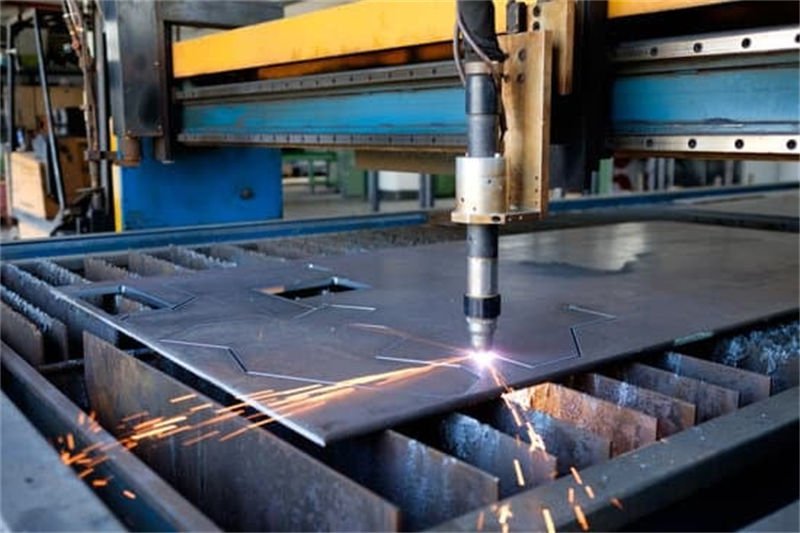
Many people have a hard time picking the best tool for slicing carbon steel. You are definitely not the only one!
Plasma cutters handle thick carbon steel well. Laser cutters offer precise results. CNC machines work with various thicknesses. Each tool has its own strengths. Your project needs decide the right tool. Precision is one factor. Cost savings are another.
The first time I cut carbon steel with a simple tool, everything went wrong. That taught me the importance of choosing the right equipment. The right choice is very important. Each tool has a specific strength. This knowledge helps you avoid wasting time and getting frustrated. Understanding each tool really helps. Let’s explore how these tools transform your project.
Plasma cutters are best for thick carbon steel cuts.True
Plasma cutters efficiently handle thicker materials due to their power.
Laser cutters are less precise than plasma cutters for carbon steel.False
Laser cutters offer higher precision, especially for detailed work.
Why is Plasma Cutting the Best Choice for Thick Carbon Steel?
Have you ever thought cutting thick carbon steel feels difficult? It doesn’t need to feel that way. Plasma cutting truly transforms how this job gets done.
Plasma cutting works very well for thick carbon steel. It cuts through heavy materials quickly. Edges come out clean and smooth. This process reduces waste. It saves time. It saves money too.

Plasma Cutting’s Special Benefits
Picture constructing a huge ship – each steel piece needs careful cutting and quick work. Plasma cutting excels here. It employs a very hot plasma arc to melt metal, then blows it away. It’s perfect for thick carbon steel, especially when other ways fail above 5-6mm. Whether working on shipbuilding1 or other structural tasks, plasma cutting finishes tasks efficiently.
Speed and Efficiency
Time equals money. This is true, especially in big projects. Once, cutting through a 10mm carbon steel plate was urgent. Plasma cutting dealt with it really fast, reducing downtime a lot. This efficiency is crucial against tight deadlines.
| Method | Speed | Suitability |
|---|---|---|
| Plasma Cutting | Fast | Thick carbon steel (5-6mm+) |
| Laser Cutting | Moderate | Thin to medium thickness |
| Flame Cutting | Slow | Very thick steel (>10mm) |
Quality and Precision
Laser cutting may be a little more precise, but plasma cutting offers more than enough quality for most jobs. Yes, cleanup is needed due to an oxide layer and slag, but for projects like steel structures2, plasma cutting remains unmatched.
Cost-Effectiveness
Examining expenses, plasma machines appear as budget-friendly options compared to lasers. They provide excellent work without draining money, which is very important in bulk manufacturing3. Also, maintaining these machines won’t surprise you with hidden costs.
Versatility and Adaptability
Plasma cutting handles various shapes and sizes of carbon steel. It adapts to switch from one project to another, whether industrial-scale jobs or custom metalworks4. It’s like having a versatile tool.
Plasma cutting is faster than flame cutting for thick steel.True
Plasma cutting completes tasks faster, reducing downtime in projects.
Laser cutting is more cost-effective than plasma for thick steel.False
Plasma machines are generally cheaper and more cost-effective for thick steel.
Is Laser Cutting the Most Precise Method?
Picture a world where precise cutting happens every time. Laser cutting brings this dream to life.
Laser cutting is often called one of the most precise ways to cut. This method is famous for its great accuracy and efficiency. It reduces waste when cutting materials. Many industries require detailed and delicate cuts. This method suits them best.

Comparing Laser Cutting with Other Methods
Laser cutting fascinates me with its precise nature. It feels like watching an artist carve masterpieces using light. Industries like automotive and aerospace rely on it for its accuracy. Laser cutting creates fine cuts with tight tolerances, often just a few microns, using focused beams. Many traditional methods find this hard to match.
Advantages of Laser Cutting:
- High Precision: Revolutionizes pattern creation on metals and non-metals.
- Clean Edges: Smooth, burr-free edges require little post-processing. Very satisfying.
- Minimal Material Waste: Efficient use of materials with narrow kerf widths brings more value. It’s like getting more for less.
Plasma Cutting5 vs. Laser Cutting
Projects needing thick steel plates sometimes call for plasma cutting. It offers speed but lacks the finesse of laser cutting. Plasma cutters slice through steel fast, but the edges end up rough, like using a hacksaw when a scalpel is better.
| Feature | Laser Cutting | Plasma Cutting |
|---|---|---|
| Precision | Extremely High | Moderate |
| Material Type | Metals, Plastics, Wood | Primarily Metals |
| Edge Quality | Smooth | Rough |
| Thickness Range | Thin to Medium (up to 10mm) | Medium to Thick (5-6mm or more) |
Flame Cutting6 vs. Laser Cutting
Flame cutting works well with very thick metals. Yet, it lacks precision. High temperatures and oxygen in flame cutting increase the heat-affected zone compared to laser technology which offers pinpoint precision.
CNC Cutting Machines and Their Limitations
I’ve used CNC machines like flame and band saws. Each one fits a specific need:
- Flame Machines: Cut thick plates but miss the precision mark; suitable where exact dimensions aren’t critical.
- Band Saws: Offer better precision but move slower and suit limited shapes.
Conclusion: Laser cutting excels in delivering accurate cuts with great edge quality on various materials. Its automation ability enhances its appeal in high-precision fields.
For more on choosing the right technology, maybe look at CNC Options7 or Laser Technology Trends8.
Laser cutting achieves higher precision than plasma cutting.True
Laser cutting offers tighter tolerances and smoother edges than plasma.
Flame cutting produces smoother edges than laser cutting.False
Flame cutting results in rougher edges due to its high-heat process.
How Do CNC Machines Handle Different Material Thicknesses?
Picture yourself in a workshop filled with the steady buzzing of machines. You wonder which CNC machine suits you best for shaping accurate parts from different material thicknesses.
CNC machines include types like laser, plasma and flame cutters. These machines work best with materials of different thicknesses. Each machine performs differently. Picking the correct one involves weighing precision, speed and expenses based on your exact requirements.

Laser Cutting Machines: Precision for Thin to Moderate Thicknesses
Laser cutting machines resemble artists with a delicate brush, suitable for thin to medium-thick materials from 0.5 to 10mm. Their precision is astonishing. I watched these machines cut complex designs into fragile sheets, leaving edges exceptionally clean. They’re perfect for tasks needing detail, like crafting precise mechanical parts. Imagine an automated artist you can trust, guided by numerical control9.
| Thickness | Precision | Speed |
|---|---|---|
| < 3mm | Very High | Extremely High |
| 3 – 10mm | High | Fast |
Plasma Cutting Machines: Efficiency for Thick Materials
Plasma cutters excel at cutting thicker materials over 5-6mm. They melt through metal using an arc of plasma, efficiently shaping with intense heat. Edges may not be super smooth – think of them as the strong, reliable friend handling heavy-duty jobs. Perfect choice for structural manufacturing tasks10.
| Thickness | Precision | Speed |
|---|---|---|
| > 5mm | Moderate | High |
Flame Cutting Machines: Budget-Friendly for Very Thick Materials
Flame cutters are practical and robust for materials over 10mm thick. They cut slowly with high-pressure oxygen, a cost-effective option for substantial tasks. Even with their slower pace and rougher edges, they fit well in industries expecting to finish the job after cutting.
| Thickness | Precision | Speed |
|---|---|---|
| > 10mm | Low | Slow |
Band Saw Machines: Precision for Medium to Small Thicknesses
Band saws offer precision for medium to small thickness materials, such as carbon steel bars or profiles. Watching them slice with accuracy reminds me of creating art from stone: slow and careful to make each cut precise.
By evaluating these machines based on your specific needs—considering factors like cutting thickness, exactness, and production size—you can select the most appropriate CNC technology for your projects.
Laser cutters are best for thick carbon steel.False
Laser cutters are ideal for thin carbon steel due to precision.
Budget impacts tool selection significantly.True
Budget affects both initial purchase and maintenance costs.
Conclusion
Choosing the right tool for cutting carbon steel depends on thickness, precision, and budget. Plasma cutters excel for thick materials, while laser cutters offer high precision for thinner sheets.
-
Explore how plasma cutting fits into structural applications like shipbuilding for its speed and efficiency. ↩
-
Explore how plasma cutting fits into structural applications like shipbuilding for its speed and efficiency. ↩
-
Learn about plasma cutting’s cost-effectiveness in bulk manufacturing scenarios. ↩
-
Discover how plasma cutting is used in custom metalwork projects for its adaptability. ↩
-
Discover why plasma cutting may be preferred over laser cutting in certain industrial applications. ↩
-
Understand the differences in precision between flame and laser cutting methods. ↩
-
Explore different CNC machine options for achieving high-precision cuts. ↩
-
Stay updated on the latest advancements in laser cutting technology. ↩
-
Understanding numerical control enhances knowledge of how CNC machines achieve precise cuts. ↩
-
Learn how plasma cutters are used in structural manufacturing for efficient material processing. ↩
-
Understanding specific task requirements is essential to ensure your tool choice aligns with project needs. ↩
-
Explore affordable tool options that balance cost with performance for carbon steel projects. ↩
-
Technical support is vital for resolving issues quickly and maintaining project momentum. ↩



